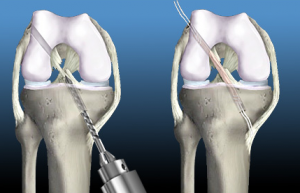Anterior cruciate ligament (ACL) reconstruction surgery is done to rebuild the ligament in the center of the knee. The ACL keeps the tibia (shin bone) in position. Any tear to the ligament will cause the knee to give way during exercise and activity. An ACL injury is often called a sprain, which is torn fibers or threads of the ligaments. An ACL reconstruction is done when there is avulsion of the ligament from either the upper leg bone or the lower leg bone. ACL sprains are more common in children than adults, and a fracture occurs when the ACL tears away from the bone and includes a torn piece of bone.
Grades of ACL Sprains
- Grade I Sprain – The fibers of the ligament are stretched with no tearing, and there is little tenderness and swelling. With this sprain, the knee does not feel unstable.
- Grade II Sprain – The fibers of the ligament are partially torn with little tenderness. However, there is moderate swelling, and the joint feels unstable during activity.
- Grade III Sprain – The fibers of the ligament are completely torn into two parts, and there is tenderness but not much pain. There can be a lot or little swelling, and the knee cannot be controlled.
Why is ACL Reconstruction Performed?
If someone has a serious ACL injury and does not have reconstructive surgery, the knee will continue to give way and be unstable. This increases the patient’s chance of developing a meniscus tear. ACL reconstruction is most often used for:
- A knee that give way or is unstable during regular daily activities.
- Persistent knee pain
- Involvement of other knee ligaments.
- Inability to continue to exercise or play sports.

Before Surgery
Before considering ACL reconstructive surgery, talk with the orthopedic specialist about how long it will take to recover. You may need to follow a rehabilitation plan for four to six months before full activity can be resumed. ACL surgery is an elective procedure, meaning it is not usually necessary. The decision to undergo ACL reconstruction should be made after discussing:
- The level of joint stability in the knee
- Your occupational and/or athletic needs
- Other damage of the knee
When is Surgery of the ACL Recommended?
ACL reconstructive surgery is recommended for patients with:
- A high degree of knee joint instability
- A complete ACL tear
- No improvement with rehabilitation and physical therapy
- A need to return to sports that require turning and pivoting
The ACL Reconstruction Procedure
ACL reconstructive surgery is usually performed under general anesthesia, but regional anesthesia may also be used. The replacement tissue will come from the patient’s body or from a cadaver donor. Some Phoenix orthopedic surgeons perform the procedure by arthroscopic means, using a tiny camera that is inserted into the knee region through a small incision. The surgeon also uses tiny instruments to repair damage and position the graft. At the end of surgery, the Scottsdale orthopedic specialist closes the incisions with sutures and covers the surgical area with a dressing.



